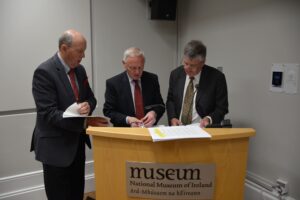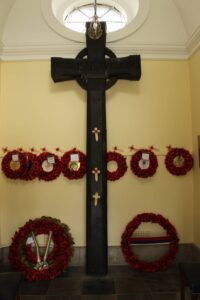SPEECH FOR THE RAF/IAC COMMEMORATION & UNVEILING OF VICTORIA CROSS STONE AT GLASNEVIN CEMETERY ON 27TH JULY 2018
written and read by Corporal Michael J. Whelan MA
It is a difficult thing to try cast our imaginations back to a time 100 years ago, but it is important that we do.
As an Irish soldier, historian and poet I am very aware that what defines our lives is vastly different to what defined the lives of those who lived during the Great War and the period of history which encompassed it, especially those in the context we are commemorating here today who contributed to the dawning of aviation. But there are similarities, in service, in loyalty and in giving your life to greater ideals and promise.
Ireland and Great Britain were different countries then, there is a term which I think stands true, THE PAST IS A FOREIGN COUNTRY, but we all still stand on the achievements and failures of those who came before us. There are threads of common history in the births of nations, the commonalities of peoples and it is important to seek these out and to remember them, to remember shared values, shared histories, shared identities, shared conflicts and it is vitally important to remember our dead, and all the victims of war. It is not always about that which divides.
But we here have other shared histories; this year 2018 marks the 100th Anniversary of the establishment of the Royal Air Force and its relevance to Baldonnel Aerodrome (now Casement Aerodrome), where I have served for almost three decades. Construction at No 23 Training Depot Station, Baldonnel, and a number of other bases began in earnest in 1917 to train pilots and aircrew, in relative safety from the war to later join the war effort. The Irish Air Corps Museum, which keeps the story of military aviation in Ireland, is housed in an old Royal Flying Corps/ Royal Air Force World War One aircraft hangar constructed in 1917. The ghosts and the stories of Englishmen and Irishmen of two different air forces still roam through the hangars there. Upon Irish independence, RAF Baldonnel was handed over to the Irish Air Service on 3rd May 1922 and to this day, 96 years later, is still the headquarters and home of the Irish Air Corps. The initial 12 pilots of the Irish Air service in 1922 had all seen service in the Great War, many of them highly decorated and at least two of whom now rest in this cemetery. It is important to remember the dark days of the Great War and to look back on that past and remember the individuals and the events that informed their lives and influenced history and the future. These were ordinary people doing extraordinary things, caught up in seismic events, not expecting to be blown by the winds of war and in many, many cases to find themselves resting on a foreign shore or in a foreign field.
Aviation was never a feature of the Anglo-Irish Treaty and negotiations in 1921 but it has been a mainstay, a measurement of Irelands progress ever since, and General Michael Collins and the Provisional Government of 1922 knew it would be vital to the commercial viability of the new State, it would also, however, become an important element of the Irish Army and the future Defence Forces. It was vital also for the new State to have a legitimately recognised military force, to be so recognised as a professional force with professional men and women within its ranks – hence the new State would be formerly recognised by other states….and Ireland, looking around found those soldiers and airmen within her own fold, trained by the British Army, Navy and Airforce, forged in the Great War and now ready to serve their own country.
Throughout the 20th & early 21st Centuries the Royal Air Force and Irish Air Corps have had an intertwined history on this island and abroad. The Irish Air Corps acknowledges that history, indeed the General Officer Commanding, Brigadier General Sean Clancy has and is very proactive in preserving those ties based on the shared histories in the landscapes of Baldonnel Aerodrome and beyond.
Our shared history with the RAF and what we are here today to remember is measured by stories of Irish airmen who went with the British forces to the Great War and who, for those who survived, carried on the mantel of aviation and brought it home here to Ireland. But there are examples of men such as that of Major Edward ‘Mick’ Mannock VC, who came to prominence during that conflict for his daring, courage and leadership and indeed because of the way he was lost but at the same time given to history. There were many like Mannock who contributed to the services, but few who resonate down the pages of history as he does.
In the deep sea, in unmarked ground, in cemeteries throughout Flanders, the Somme and across, England, Ireland, Europe and the world are the final resting places of Irishmen and women who perished while serving in British uniform with the allied armies during the Great War. But it does not matter where these men and women served, where they fell or where they rest. The only recourse that falls to us after this passing of time is to try to understand, we cannot judge. These men and women are part of the Irish story, the narrative of our countries, the historiography of this island. It is right to bring them all home now, to Ireland.
In the final measure at the end of the day, all those good soldiers, all those good sailors, all those good airmen, all the good men and women who did their duty by their lights are exactly the same in the commonalities of the service they were called upon to perform. They tried to survive the quagmire; all they could really hope for was to be remembered.
Michael J. Whelan





